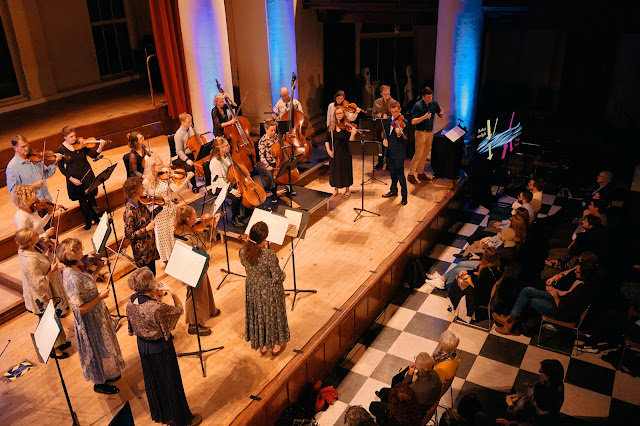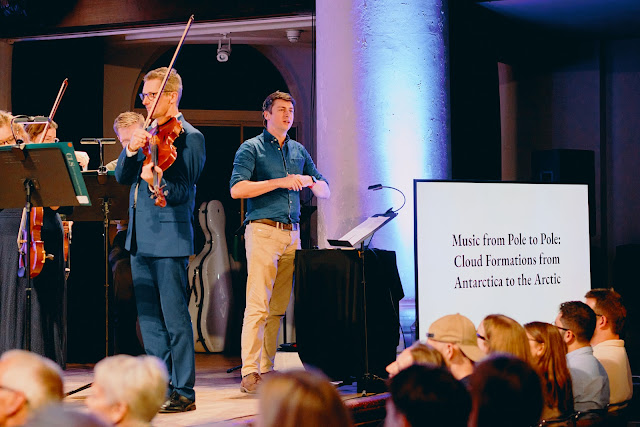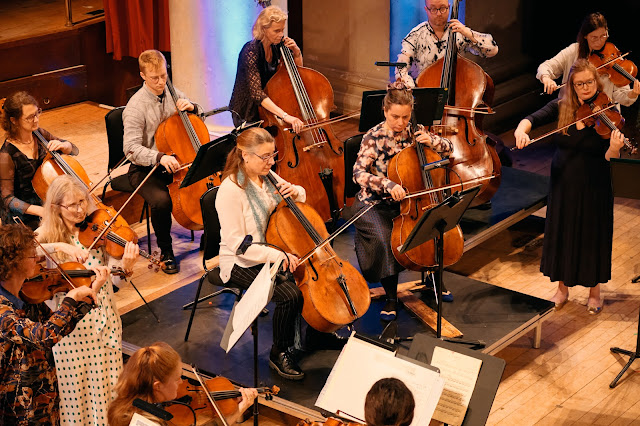 |
| Music from Pole to Pole – City of London Sinfonia and Dr Simon Clark at Smith Square Hall – (Photo: Suzi Corker) |
Music from Pole to Pole: Caroline Shaw, Webern, Dvorak, Lutosławski, Osvaldo Golijov, Marais, Vivaldi, Thomas Adès, Anna Thorvaldsdottir, Bach; Dr Simon Clark, City of London Sinfonia; Smith Square Hall
Reviewed 15 October 2024
Cloud formations and music in a fascinating mix of informed talk and challenging music to create a bravura mix that made us leave wanting more
City of London Sinfonia‘s (CLS) Patterns of Nature series involves the ensemble sharing the platform with those outside classical music in an intriguing mix of talk and concert (much in the way that the Orchestra of the Age of Enlightenment does with its Bach, the Universe and Everything series). For the second of CLS’ Patterns of Nature, at Smith Square Hall (St John’s Smith Square) on Tuesday 15 October 2024, the title was Music from Pole to Pole with the tag line Cloud formations from Antarctica to the Arctic where CLS, director Alexandra Wood, was joined by atmospheric physicist Dr Simon Clark, a science communicator and author who specialises in studies of the Earth’s atmosphere.
Quite how the music and science were going to match up was unclear, but the programme for the evening was definitely not pulling any musical punches with Caroline Shaw‘s ‘in manus tuas’, movements from Webern’s 5 movements for string orchestra, Op. 5, Dvorak’s Nocturne in B flat, Op. 40, the epilogue from Lutosławski’s Musique funèbre, the first movement of Osvaldo Golijov’s Last Round, the tempest from Marin Marais’ Alcione, two movements from Vivaldi’s Concerto in G minor Op. 8 No. 2 ‘Summer’, the movement O Albion from Thomas Adès‘ Arcadiana, Op. 12, three movements from Anna Thorvaldsdottir‘s Spectra and the aria from Bach’s Goldberg Variations. And we began, in almost total darkness, with a terrific performance of Joely Koos of Caroline Shaw’s solo cello piece ‘in manus tuas’.
 |
| Music from Pole to Pole – City of London Sinfonia and Dr Simon Clark at Smith Square Hall – (Photo: Suzi Corker) |
Inspired by Shaw’s hearing of Thomas Tallis’ motet of the same name, the music moved between white noise and more formal Baroque-inspired structures, including singing from the cellist herself, to create something that suggested an underlayer of music of an earlier age without ever quite revealing it. Afterwards, Simon Clark explained that the piece was no so much about the Tallis’ motet as intended to evoke Shaw’s feelings on experiencing it being sung, and after the talk he wanted us to be able to see the atmosphere through his eyes.
Clark took us on a journey from Antarctic to Artic, stopping off at each point to describe the cloud formations typical of the area and to evoke them with music, requiring from us an imaginative leap. The pieces chosen were certainly not musically simplistic and not always obviously descriptive. CLS gave us some terrific performances and the result was a themed programme with an imaginative difference.
Clark proved to be an engaging speaker, managing to sum up a particular cloud formation in a few words describing and explaining how that particular cloud came about, but he was also entirely unphased when talking about the music so that the two seemed logical complements (he is evidently musically literate and was a choral scholar in the University of Exeter Chapel Choir).
First stop was the Nacreous clouds of the Antarctic, with the middle three movements of Webern’s 5 movements for string orchestra. It is amazing quite how romantic this music can sound to modern ears. CLS brought a warmth to the writing, the second movement was austere but with underlying passion, whilst the third movement was filled with anxiety and violence in a very filmic manner, and the fourth was full of expressive fragments, evanescent yet with surprising warmth.
Next stop was the Southern Ocean, one of the cloudiest parts of the Earth, and Stratocumulus clouds, evoked by the unhurried meandering of Dvorak’s Nocturne in B. Then in South America we encountered Nimbostratus, dark grey slabs of moisture that bring continuous rainfall. Here was the final movement of Lutosławski’s Musique funèbre, written in memory of Bartók, strong, intense and uncompromising with dense harmonies leading to spare austerity. It was a performance that made you wish the programme had been a little longer, allowing complete performances.
In the Sub-tropics we encountered Arcus clouds, strong, cool and dynamic, and here was the first movement of Osvaldo Golijov’s Last Round, written after the death of Astor Piazzolla and evoking the violent compression of his favourite instrument, the bandoneon. Written for two competing string quartets, with a lone double bass between them, the music began gritty with vivid rhythms and moved with increasing energy until a fast and furious ending. This was a performance of terrific energy and sophistication, a tour de force from the players. Then in the Tropics we encountered Cumulonimbus, with Clark getting excited about their description saying that this would be some of the most violent weather we encountered. And to pair with them was the Tempest from Marin Marais’ 1706 opera Alcione, full of colour and movement with clear excitement from the players and a wonderful contrast to the Golijov, equally full of vivid energy yet completely different.
Moving further North, we encounter Altocumulus Castellanus, described by Clark as fluffy little castles yet harbingers of thunder and lightening, cue the final two movements from Vivaldi’s Summer ;from The Four Seasons, with Alexandra Wood as the solo violin. Vividly strong textures and an intense solo leading to real violence with a strong edge and rushing scales. This was edge of the seat stuff, perhaps not a performance for every day but in context it was terrific.
In the North Atlantic, another cloudy region, we encounter Cirrus which is made of ice crystals, not water droplets, and we can observe the same cloud formations on other planets. Clark explained that clouds have a complicated relationship with Earth’s temperature, and Cirrus clouds are surprisingly successful at trapping heat in the atmosphere. They were evoked by O Albion the sixth movement of Thomas Adès’ Arcadiana, which with its sense of suspended beauty seemed to evoke Englishness incarnate.
In the Arctic we encounter our final clouds the fascinating Noctilucent; clouds that should not really exist. We heard three movements from Anna Thorvaldsdottir’s string trio, Spectra performed by Alexandra Wood, Ian Rathbone and Joely Koos, aetherial textures, string slides and harmonics creating transparent wisps of sound, sometimes barely there. As the music gained definition it remained extremely evocative, the three players creating that distinctive sound world that evaporated into atmospherics. And we finished with the Aria from Bach’s Goldberg Variations, played by the trio. Pure magic.
 |
| Music from Pole to Pole – City of London Sinfonia at Smith Square Hall – (Photo: Suzi Corker) |
That the evening worked is partly due to Simon Clark’s easy engagement both with his subject and with the music, but also due to the terrific performances from City of London Sinfonia. Across a wide range of styles and eras they gave accounts of the music that really lifted it off the page. We had virtuosic bravura, quiet intensity and everything in between; without exception, they made you want to hear more of the shorter excerpts
The blog is free, but I’d be delighted if you were to show your appreciation by buying me a coffee.
Elsewhere on this blog
- Sound magic: En Couleur from the percussion group, Trio Colores – record review
- From expressionist nightmare to radiant energy: Schoenberg’s Pierrot Lunaire & Schubert’s String Quintet at Hatfield – concert review
- Charpentier’s Actéon & Rameau’s Pygmalion: a perfect double-bill offering a delightful, entertaining evening – opera review
- Intimate & communicative: Solomon’s Knot brings its distinctive approach to Monteverdi’s Vespers of 1610 at Wigmore Hall – concert review
- Waiting till they feel they have something to say: I chat to Trio Bohémo about their debut disc – interview
- On tour from New York, the Philip Glass Ensemble stopped off in Cambridge in a presentation by the Cambridge Music Festival – concert review
- Everyone clearly enjoyed themselves & brought the house down: The Sixteen in Monteverdi’s Vespers of 1610 at Temple Church – concert review
- Une messe imaginaire: Bruckner & Frank Martin from Lyon – record review
- What lies beneath: a brilliant reinvention of Judith Weir’s Blond Eckbert at the heart of ETO’s exploration of German Romanticism – opera review
- A glorious noise: from one to eight choirs in I Fagiolini’s evening of music from 17th-century Venice and Rome – concert review
- Home


.jpg?w=998&resize=998,665&ssl=1)






